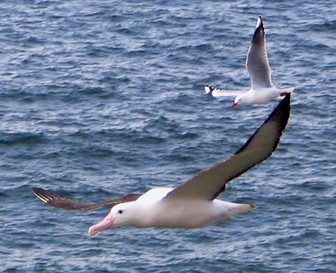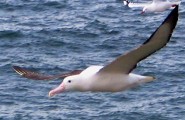Northern Royal Albatross
The Northern Royal Albatross or Toroa,

Original source: XLerate
Author: XLerate
Permission: GNU Free Documentation License
Northern Royal Albatross - Romeo and Juliet
 The Northern Royal Albatross (Diomedea sanfordi) is a remarkable traveler, covering millions of miles over the Southern Ocean during a life span that can be more than 50 years. Yet the bird remains faithful to one mate for that same long life, and returns to the same nesting site for decades.
The Northern Royal Albatross (Diomedea sanfordi) is a remarkable traveler, covering millions of miles over the Southern Ocean during a life span that can be more than 50 years. Yet the bird remains faithful to one mate for that same long life, and returns to the same nesting site for decades.
The Northern Royal Albatross is one of the largest seabirds, with an average adult being about 1.15 meters, or 3 feet, 9 inches, from beak to tail. They have an astounding wingspan of 3.2 meters, or 10 feet, 6 inches. The birds are white, with black on the top of the wings, and have pale pink bills with a black edge on the upper beak section.
The Northern Royal Albatross lives in the Southern Hemisphere. Its major breeding grounds are in the Chatham Islands, a remote archipelago east of New Zealand. When not raising chicks, they spend up to a year gliding the high air currents over the Southern Ocean, not touching the ground for months on end. The major portion of their diet is squid and fish, which they catch and consume on the wing.
The Royal Northern Albatross is very long lived, with the oldest birds reaching over 60 years old. They pair for life, meeting at the same nesting site for each breeding season. They have a two year breeding cycle; a single egg is laid in mid-November to mid-December, late spring to early summer in the southern hemisphere. The chick is not ready to leave its parents until the following October, and the adults then spend the next year traveling and eating before meeting again.
The Northern Royal Albatross has no natural predators, but ferrets and cats, introduced into the islands where the birds nest, take eggs and kill chicks. When over the oceans, the birds frequently tangle themselves in fishing equipment while trying to catch fish.
The Northern Royal Albatross is an endangered species. The bird has a very small breeding range, and in the 1980s major storms degraded that habitat, making parts of it unsuitable for use by the birds and the number of chicks raised successfully crashed. Because they breed so slowly, the effects of that crash will last for decades. Recent indications are, however, that the population has stabilized more quickly than expected. Biologists are now cautiously optimistic that this magnificent bird will be a part of the Southern Ocean ecosystem for a long time to come.
Picture of the Northern Royal albatross by XLerate, licensed under Creative Commons Attribution-Share Alike 3.0 Unported license.
The Northern Royal Albatross is classified as Endangered (EN), considered to be facing a very high risk of extinction in the wild.
Family : Diomedeidae
Genus : Diomedea
Species : sanfordi
Authority : Murphy, 1917

